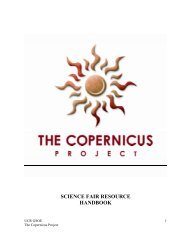Action Research Summary - Copernicus Project - University of ...
Action Research Summary - Copernicus Project - University of ...
Action Research Summary - Copernicus Project - University of ...
Create successful ePaper yourself
Turn your PDF publications into a flip-book with our unique Google optimized e-Paper software.
Compiled and Written by Jocelyn Edey and Steve Gómez<br />
1<br />
<strong>Action</strong> <strong>Research</strong> <strong>Summary</strong><br />
<strong>Copernicus</strong> <strong>Project</strong><br />
SSI Year 4: K-6 Literacy through Science<br />
Use <strong>of</strong> Technology in the Classroom (5 studies)<br />
I. <strong>Research</strong> Question: If I incorporate technology into the 5E lesson approach, will<br />
students have a higher interest in learning?<br />
<strong>Summary</strong> <strong>of</strong> Results and Implications: Teacher researcher acknowledges limits <strong>of</strong> this<br />
particular study to answer the original research question. However, this study did find<br />
significant increases on two measures – 1) Student technology exposure and interest<br />
towards science instruction/technology infused instruction, and 2) Student technology<br />
exposure and interest towards science instruction: Traditional vs. Technology infused<br />
lesson.<br />
In general, this study found that incorporating technology into lesson plans may<br />
increase student interest and engagement. Teacher researcher argues that this can<br />
have positive influences on student performance throughout the year and would like to<br />
continue research to if effects are sustained over longer periods <strong>of</strong> time.<br />
II. <strong>Research</strong> Question: Does using technology (including Discovery Streaming’s webbased<br />
videos and clips, You Tube video clips, “Googled” pictures and diagrams,<br />
PowerPoint, etc.) help my second grade students understand the science concepts<br />
better, as evidenced by scores on quizzes or tests?<br />
<strong>Summary</strong> <strong>of</strong> Results and Implications: This study was conducted for practical purposes.<br />
The teacher researcher was curious about understanding just how effective technology<br />
is in helping students comprehend science material better. This study would help inform<br />
the teacher researcher as to how much technology and when to implement technology<br />
into a lesson so that it helped his students perform better.<br />
The data in this particular study did not support the researcher’s hypothesis that use <strong>of</strong><br />
technology would help bring student test scores up. The data collected showed no<br />
difference in total average scores between lessons that used some form <strong>of</strong> technology<br />
and lessons that didn’t. Teacher researcher attributes these results to the limits <strong>of</strong> his<br />
research design which made used <strong>of</strong> “pre-made “comprehension examinations provided<br />
by the textbook publisher Macmillan McGraw/Hill.<br />
III. <strong>Research</strong> Question: Will the utilization <strong>of</strong> technology during science instruction<br />
promote interest, improve confidence, and increase science test scores?<br />
<strong>Summary</strong> <strong>of</strong> Results and Implications: Teacher researcher conducted this study<br />
because <strong>of</strong> a lack <strong>of</strong> experience in integrating technology in the classroom. This study<br />
would help inform the teacher as to what effects technology can have on student<br />
The <strong>Copernicus</strong> <strong>Project</strong> is 100% funded by the<br />
United States Department <strong>of</strong> Education Office <strong>of</strong> Post-Secondary Education<br />
Teacher Quality Enhancement Grants Program<br />
Awarded to the<br />
<strong>University</strong> <strong>of</strong> California, Riverside<br />
Graduate School <strong>of</strong> Education
Compiled and Written by Jocelyn Edey and Steve Gómez<br />
2<br />
comprehension and performance and would help determine this teacher’s focus on<br />
updating her own technology skills.<br />
A quantitative pre/post test design was used to collect data. Surveys were administered<br />
to students before intervention and shortly after. Results were not conclusive and did<br />
not indicate a relationship between technology implementation and student<br />
performance. Teacher researcher attributes the results to poor evaluation tool and<br />
flawed research design.<br />
IV. <strong>Research</strong> Question: Will the use <strong>of</strong> technology improve supplemental assignment<br />
completion rates and sight word reading skills in kindergarten students?<br />
<strong>Summary</strong> <strong>of</strong> Results and Implications: The purpose <strong>of</strong> this study was to determine if<br />
adding technology support (Biffy 50 Toons DVD) for the students’ “Cookie Crunchers”<br />
assignment would improve 32 Kindergarten students’ ability to instantly recognize sight<br />
words for continued reading success.<br />
A pre/post test quantitative research design was used to collect the data. Teacher<br />
researcher acknowledges lack <strong>of</strong> control for external variables, such as student English<br />
pr<strong>of</strong>iciency. Nevertheless, this study demonstrated positive results after implementing a<br />
technology-based intervention on teaching the students sight words. In comparing the<br />
pre-test and post-test results, there was a sharp rise in student achievement after the<br />
implementation <strong>of</strong> technology. Teacher researcher found that using the Biffy 50 Toons<br />
DVD, students became actively engaged in learning sight words without help from their<br />
parents. Teacher concludes that the use <strong>of</strong> technology improved supplemental<br />
assignment completion rates in Kindergarten students in this classroom.<br />
V. <strong>Research</strong> Question: Do my first graders test scores, thereby their achievement,<br />
increase in science with the use <strong>of</strong> technology?<br />
<strong>Summary</strong> <strong>of</strong> Results and Implications: Teacher researcher divided students into two<br />
separate groups to conduct this research. One group was designated the ‘control’ group<br />
the other received an intervention consisting <strong>of</strong> increased use <strong>of</strong> technology<br />
(PowerPoint). Data was collected from 19 students in a first grade classroom.<br />
Teacher researcher found significant differences in the performance <strong>of</strong> both sets <strong>of</strong><br />
students. On average, students in this study scored 10% higher in the treatment group<br />
versus control group leading researcher to conclude that indeed technology had an<br />
effect on the students’ performance. Even when the data were broken up by gender, the<br />
researcher found the 10% increase to remain true even by gender (both girls and boys<br />
in the intervention group scored better than their counterparts in the control group).<br />
The <strong>Copernicus</strong> <strong>Project</strong> is 100% funded by the<br />
United States Department <strong>of</strong> Education Office <strong>of</strong> Post-Secondary Education<br />
Teacher Quality Enhancement Grants Program<br />
Awarded to the<br />
<strong>University</strong> <strong>of</strong> California, Riverside<br />
Graduate School <strong>of</strong> Education








